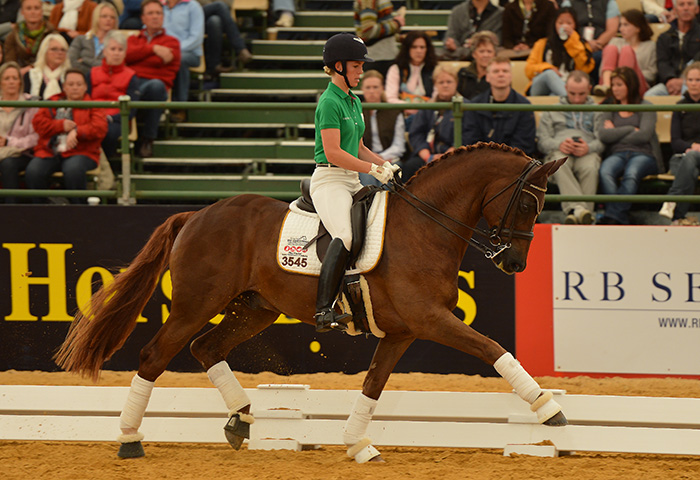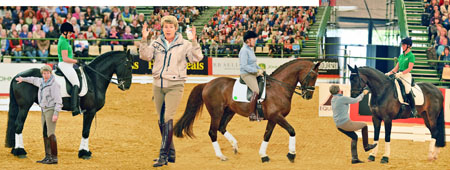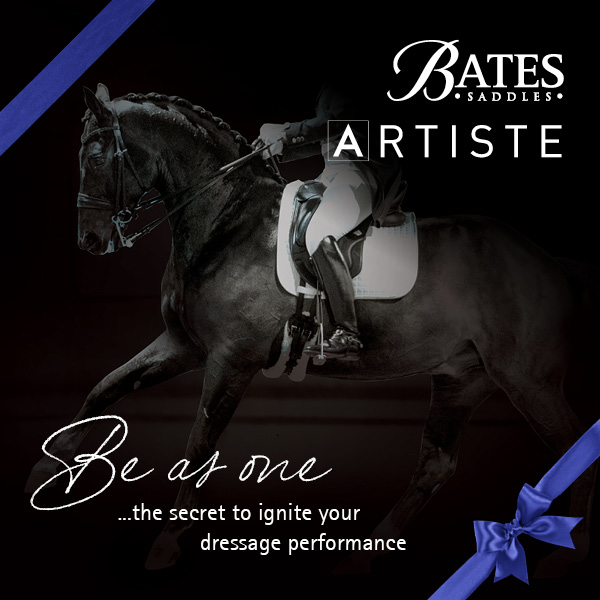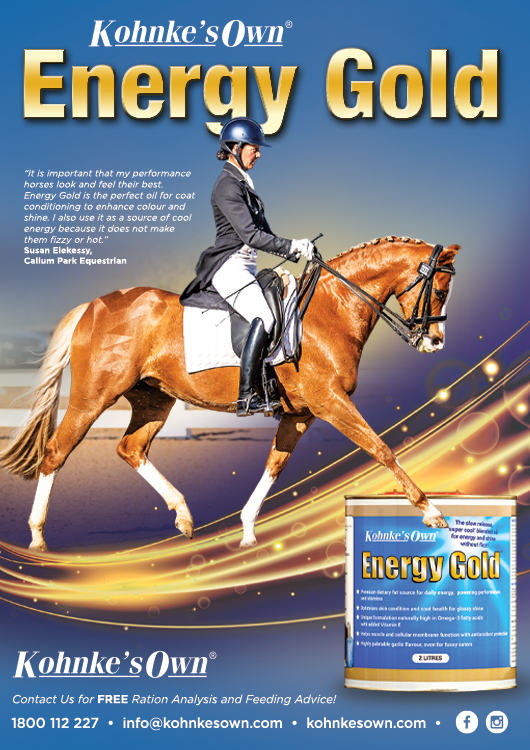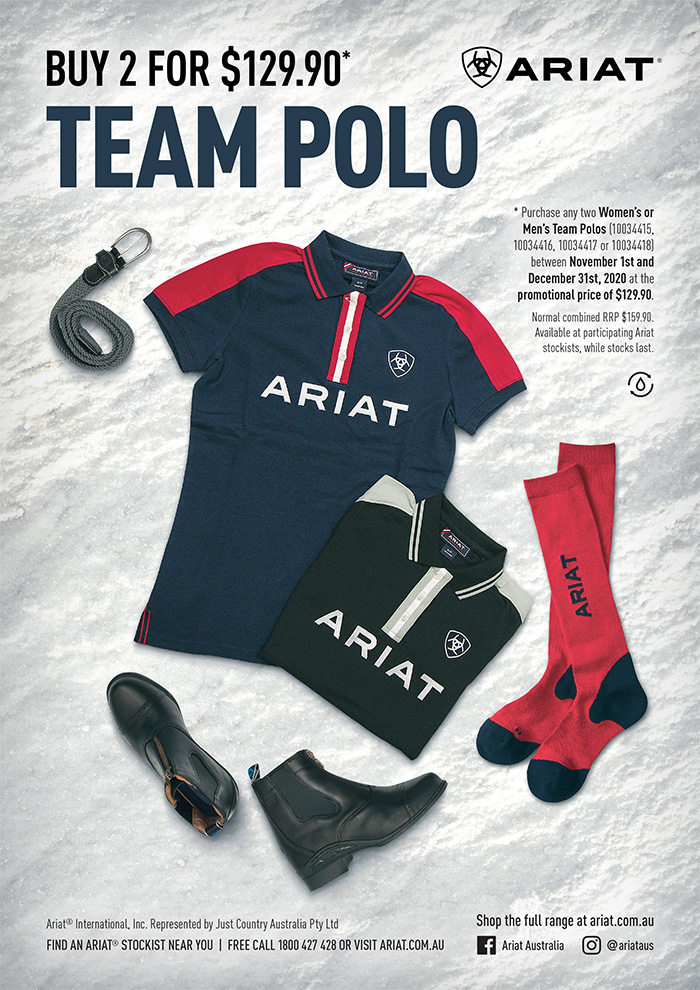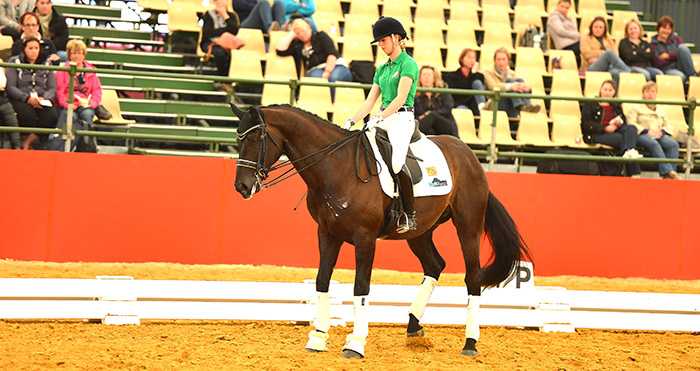Problems That We Can Fix with Kyra Kyrklund, written by Susan Mackenzie, pix Roslyn Neave
Kyra Kyrklund conducted the Masterclass at Equitana 2012, and while plenty of things went wrong with individual horses, Kyra showed the audience how to work through these issues and the class was very informative, very practical and an excellent production by the Finnish rider, who is quite the show woman and had the audience enthralled.
I took up position on the Wednesday at the selection class for the masterclass to see which horses and riders would make the cut. Kyra and her partner Richard White watched sets of horses come and go, with the only instructions “work them as you would normally” and the occasional request for a different gait or specific movement. I asked what they were looking for:
“Problems that we can fix,” laughed Richard.
“We look first at the movement,” said Krya, “but not just at this, we don’t just want to show paces. We want to show common problems and then show how we can resolve them – hopefully. I don’t work with the riders before the clinic, so that I can show the changes here in front of the audience.”
“In former times, horses were used for warfare, so the rider’s welfare depended on how well the horses were trained. Now it’s only our ego that takes a bash if the horses don’t do what we want them to do.”
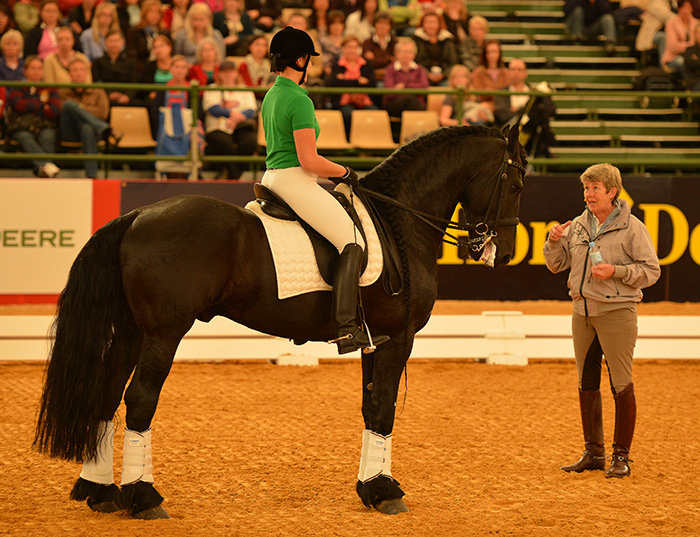
Kyra starts off, “if you squeeze too much in the middle it’s a bit like a sausage and both ends go ‘blehhch’. Riders “sit in a hole” in the middle of the horse, driving down, “It is uncomfortable to sit in a hole in the back.”
“All riders struggle with the same problems, one is to be able to sit comfortably.”
“The best thing for the rider, is to have a horse that gives the right feeling, so they feel it themselves, it’s something you can’t explain. Riding is feeling, a sense like touch, taste, hot, cold.”
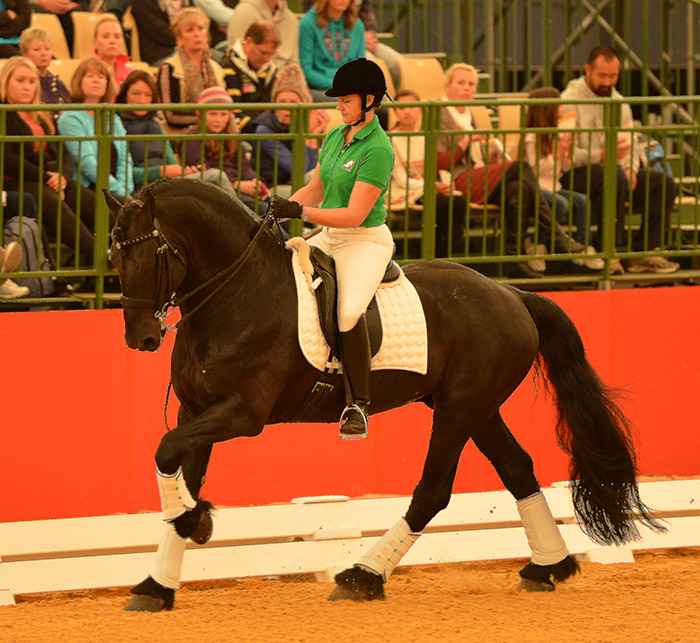
So, first up we have Natasha Althoff-Kelly on Ebony Park Abe, a 12-year-old Friesian stallion. At the selection they threw off changes easily around the arena but struggled in piaffe, shuffling forward instead of staying on the spot. Guess what Kyra has chosen to work on?
“The piaffe is going forward rather than on the spot, which is OK for a young horse who is just starting out, once he gets a bit more collected he will be able to stay on the spot.”
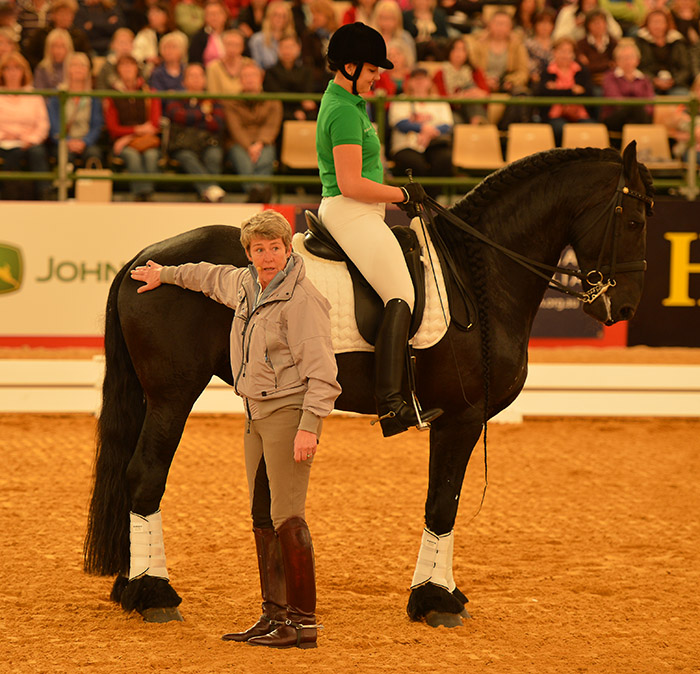
“Most riders focus on getting the legs moving to piaffe, but it’s really the trunk of the horse that needs to shorten first.”
“Your centre of gravity is somewhere near your tummy button. You should try to keep that quite low. A ballet dancer keeps their centre of gravity high, you should keep your centre of gravity low.”
Kyra tells the audience to think of the horse’s ribcage as a spring that needs tension, emphasising that muscles work in pairs; to bend your arm, one muscle lengthens and one shortens.
“So we need the under-line of the horse shorter so the over-line gets longer; an arch bridge instead of a hanging bridge.”
Kyra explains that if the under-line of the horse is shorter, then it is easier to get the hind leg to come under, if the under-line is long then he can’t move the leg under himself.
“You need to think about his tummy muscles, not his legs, until you have something to sit, on there is no point asking him to piaffe – or any other movement.”
Kyra makes them stop and starts poking Ebony Park Abe around his belly, when she gets to a spot just behind the girth his whole body lifts up and he is carrying Natasha, she is not sitting “in a hole”.
“It’s not squeezing with the whole leg, it’s almost just your foot. You need to activate those tummy muscles until you get the same feeling as when I was pinching him.”
As they try again Kyra’s mantra is “sit down, sit down, sit down”, but she quickly emphasises, “you are doing too much with you seat. Without any leg try and move your bum like you would in piaffe… Nothing. See, they don’t really go from the seat, but by the leg, but only once he is engaged.”
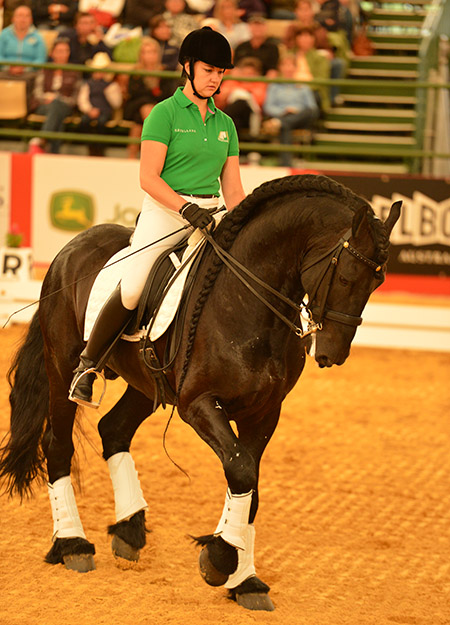
“Breathe in, hold that breath to get the weight down at your hips. Breathe heavy.”
“You want the feeling to sit and the leg to create the piaffe.”
Natasha is really trying, you can see her position adjusting and her seat is less of a driving force but rather a weight on the horse’s back, looking for the feeling rather than the stamping of the feet.
“Concentrate on the feeling underneath you, balance him with your hand. Sit heavy, tap, tap, tap, not hard, ask him for the rhythm you want, not the rhythm he chooses to go in.”
The stallion piaffes on the spot, collected, balanced with a rider really switched on to what she is doing. The audience bursts into applause.
more follows
Kyra praises her, but reminds her, “don’t be ahead of him, you have to feel ‘ah now I have energy, what do I do want to do with it’.”
It’s a theme for the masterclass, focusing on waiting for the feeling, for the energy and then choosing what to do with it, not rushing into the movements without the correct feeling. It seems like the pressure of going up the grades and having to produce a movement at a marker has stressed out these riders, Kyra strips back the movement to the feeling that they want; not allowing the precise movement until the feeling is there.
next Kyra rides for us
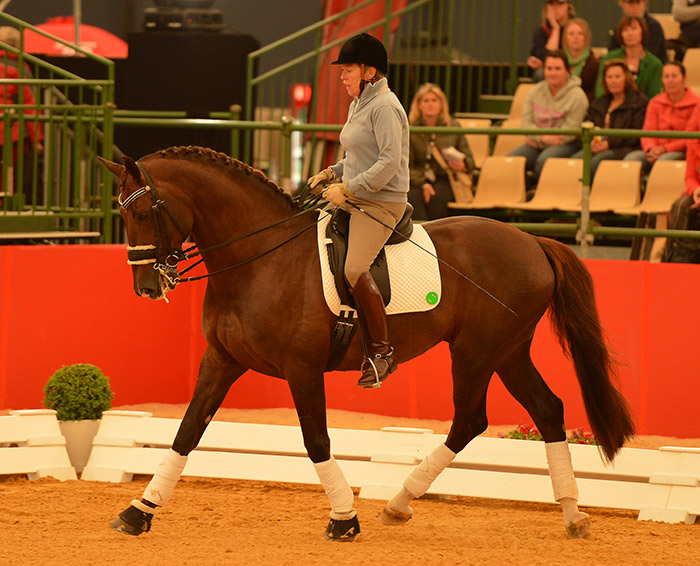
Next into the arena is Rendezvous, aka Raspberry, owned by Cheryl Fort and with Kyra in the saddle. Kyra has already ridden Raspberry a few times at Mary Hanna’s stables. Today the stallion is just a little bit freaked out by the atmosphere in the big tent… “He’s looking very nervous, so as you can see here I don’t even try to take him near scary things.”
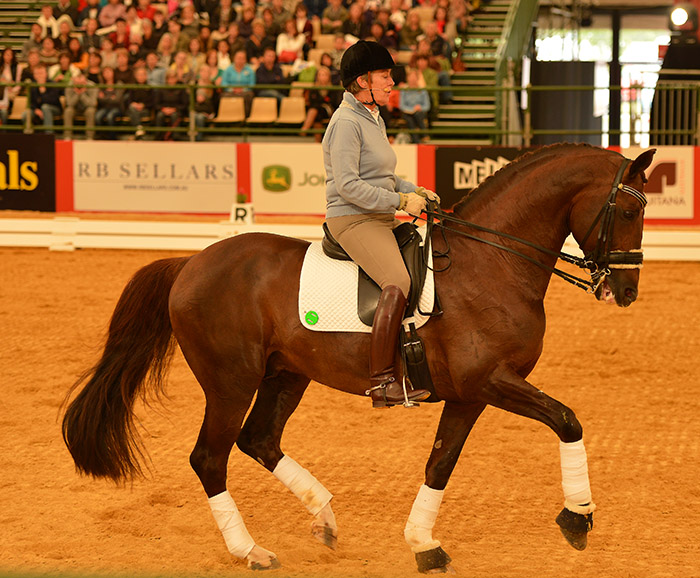
While they try to establish a nice rhythm in the trot Raspberry gets confused and piaffes. Kyra smiles and pats him, “he’s just learning that, so even though it’s not what I really want, he is learning and he is trying.”
Not only is Raspberry having to cope with a big crowd and big top tent, but the Scottish Society are helpfully rehearsing their bagpipe band somewhere on the showgrounds, so the stallion trots around in time to the skirl of the pipes.
Kyra is unfazed by Raspberry’s exuberance and just carries on, tuning him in and using the time to extend her discussion on position as we can now see what she is talking about. “I try to stay relaxed in my upper body, I don’t try to squeeze my body down, I almost let myself bump with the horse. I let him bump me up. The biggest muscle we have is the tummy muscles so I try to take no tension in the back, just in the tummy.”
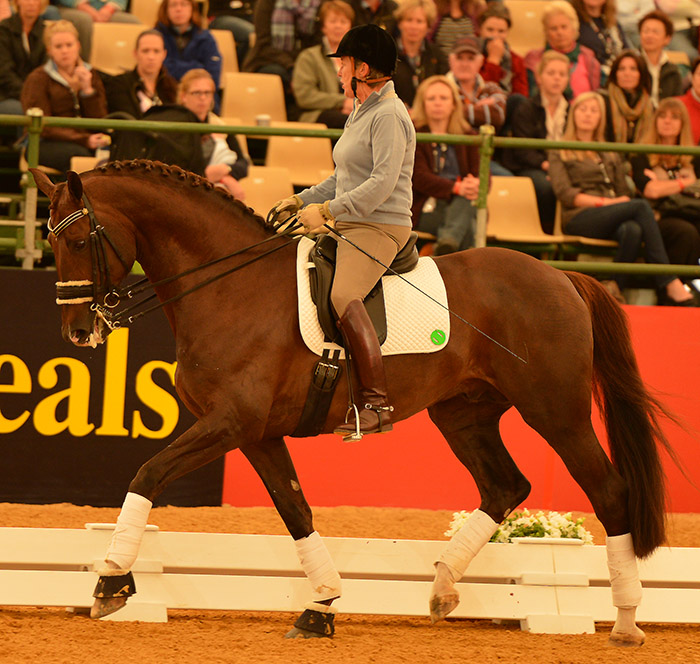
“I try to stay relaxed in my hip joint. Lots of trainers say “long legs” and then you try to push your legs down and you squeeze down. I prefer to say, toe up, carry the toe and carry your own leg. In principle I can take it away from the horse and use it how I want.”
Kyra jokes that the horse doesn’t like the right rein very much: “If you make a freestyle for him you should try to do more on the left!”
“I try to feel the horse in my elbow, not in my fingers. I think of fingers as hooks that hold the reins but I feel the horse in my elbows.”
She continues tuning him in with a series of leg yields across the diagonal, but not going the whole way. A few steps sideways in trot, back to walk, walk forward, trot forward, a few steps sideways, back to walk.
“If I take the leg too far back, which a lot of riders do, then I’m weak and then I’m tense in my legs and he will just drag me along. I need to sit on my bum and use my legs individually.”
“Tense muscles don’t feel as much as relaxed ones and can’t work independently.”
When they try to passage Raspberry goes very slowly, which Kyra pounces on, “he’s going too slowly, so again I sit, I use my legs independently to ask for the rhythm that I want.”
“In a test you would be marked down for this passage as I am having to adjust it and he’s not in the rhythm, but in training you have to be happy for every better step that you get.”
They move on to canter work and once the canter is established they work on pirouettes.
“For a pirouette I need straightness, I need self-carriage, I need the shorter step and I need the ability to influence the step. I train each part separately.”
Kyra explains that collection is just as important for pirouettes and works on getting the canter shorter without the horse anticipating: “we don’t want him to go, oh we’re doing a shorter canter, oh this is where we pirouette.”
They canter on the circle, getting shorter and shorter, but not tense. Kyra asks him to move in about two steps, then straight back to the circle, “I praise him for every good step, I don’t just ask for more, more, more.”
They progress to a half-pirouette but Raspberry starts to push his shoulder out at the end so they go back to the circle and try again, “See there he took over, he decided to bulge out, no, no, don’t take over, so I just make the pirouette bigger, ask for less.”
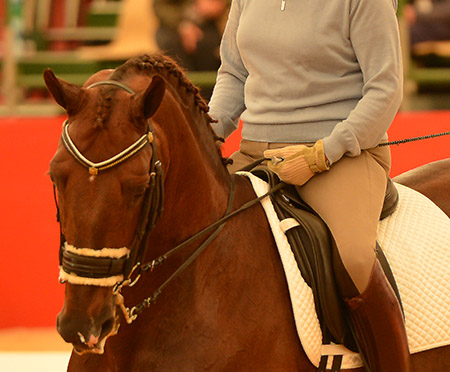
Kyra is riding with the two curb reins and her outside bradoon rein in her outside hand, and just her inside bradoon rein in her inside hand. She calls this the 3 + 1 method, which enables her to really feel the different reins and this method also helps her control the horse’s shoulder.
Breeding dressage horses? International Horse Breeders have a great selection of stallions available for 2020 Go to www.ihb.com.au
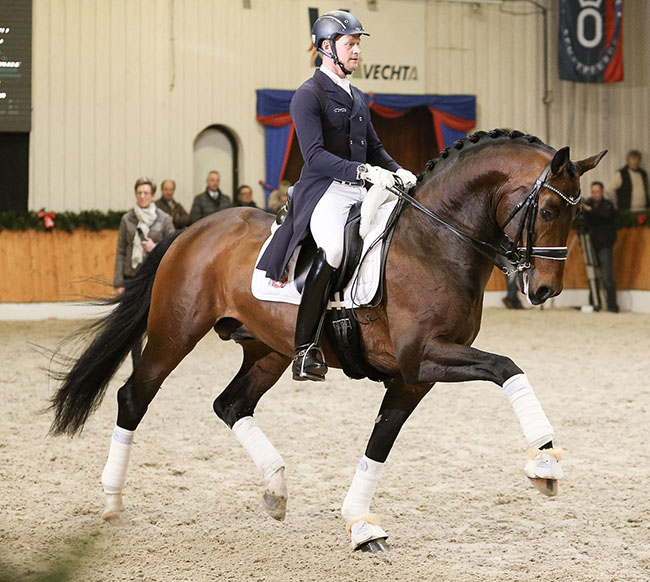
Foundation
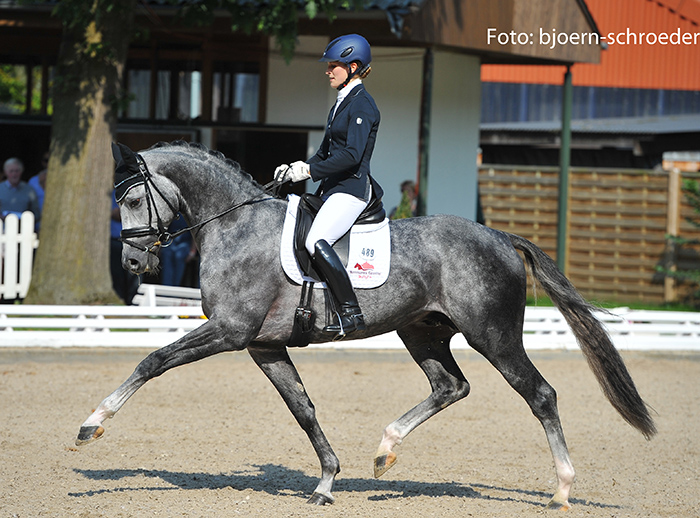
Belantis
Robbie Soster and her lovely mare Danora enter along with Sharyn McCombe on Yarramee B Bear. Danora is a five-year-old and still in preliminary, but hasn’t scored under 70%, and Yarramee Be Bear is seven, going up to Prix St Georges.
Robbie, who is such an elegant rider, is described as “a rider who rides well in the rhythm of her horse. She is following the horse in a nice way but now it is time for the horse to start developing her trot.”
“Sharyn’s horse has a lot of movement but Sharyn has a problem getting comfortable.” It’s a lovely way of putting it, we’ve all been bounced out of the saddle by a big moving horse and been frustrated, but when Kyra describes it, it seems perfectly understandable.
The first thing she works on is to “improve cooperation between the hand and the leg”.
She gets Robbie to halt and stands in front of the horse taking the reins on either side. She pulls the reins away from Robbie’s hands and Robbie’s first response is to grip with her legs to brace against the pressure. The horse moves forward. Before they repeat the exercise Kyra discusses the strength of the tummy versus the strength of the legs. Kyra pulls on the reins, almost hanging off them, but this time Robbie has engaged her core to stabilise herself and not only does the horse stand still, but this time it lifts its back up to carry her rider.
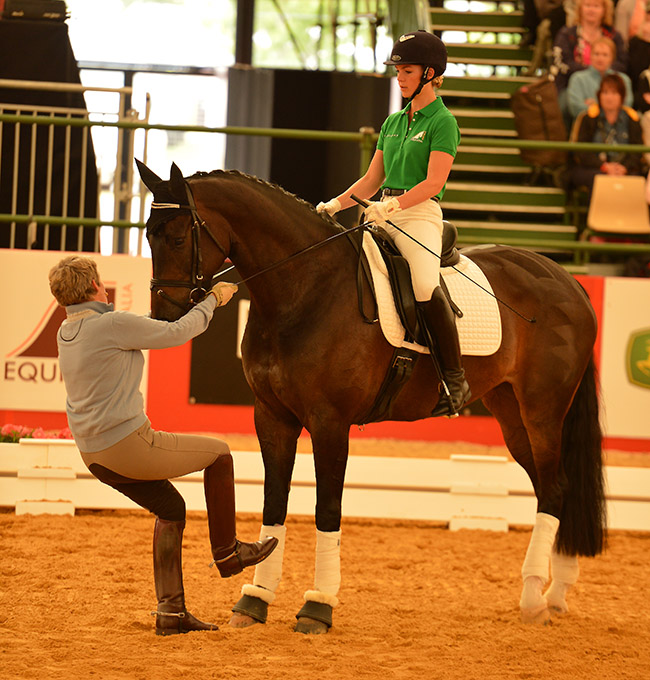
“See, she carried herself. Think of pushing your intestines to your tummy button without letting fall out. If you only use your back when you’re riding, you will be in trouble.”
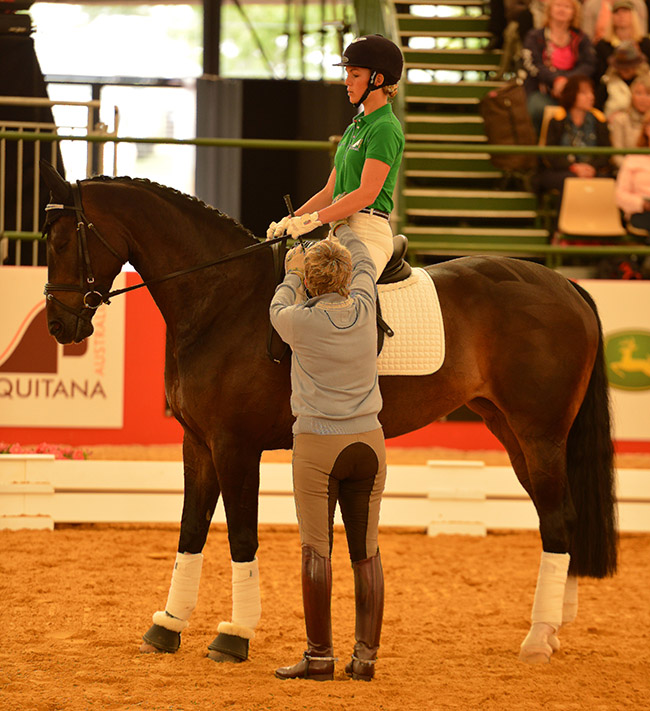
They try again, this time with Kyra adding the instruction to “almost feel like you can lift your legs from the hip joint, and your hand is only a hook, you’re carrying her through your elbow.”
Kyra hangs off the reins again, Robbie follows her directions and up comes the mare’s back and they stay there.
“Good, you have to have be able to say, ‘excusez-moi I’m going to stay here, I’m not being pulled forward’, and she will learn that.”
.Robbie was asked to hold the monkey grip on the front of the saddle, allowing her to focus on using her weight to stabilise herself.
“Don’t try and push the seatbones down, think of sitting on a cushion and let yourself be there.”
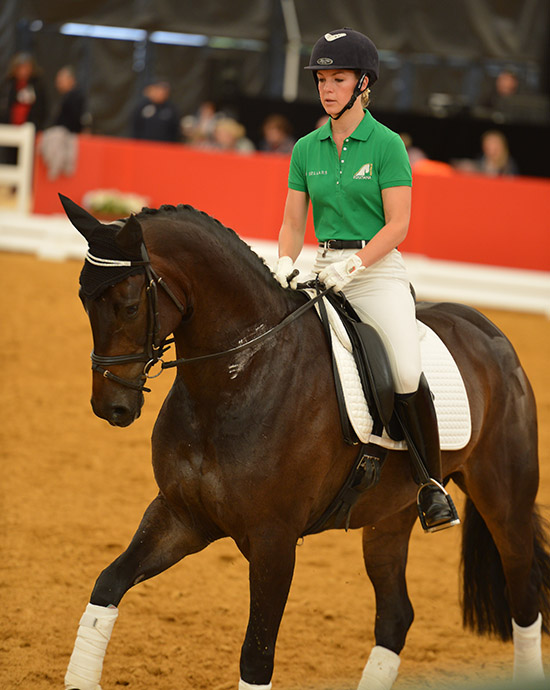
“Robbie, your mare is nice, but she is doing a little bit too much the same trot. You need to get better at influencing that trot. It’s not just about her lifting her front legs, you have to engage ribs and back leg. Use your lower leg in the rhythm you want, shortening and lengthening the steps, feel it in your elbow.”
“You’re pushing here [Kyra grabs Robbie’s thigh near her knee] but you need to think you can lift the leg from the hip.”
Kyra emphasises the importance of trying new things, “if you always do what you’ve always done, you’ll always get what you’ve always got”.
“Change is very uncomfortable. You have your technique and you do it fairly well, but you always have to improve. Think of watching a Grand Prix test, there are plenty of riders who can do a nervous trampling on the place and call it piaffe, but you need to improve and aim for better.”
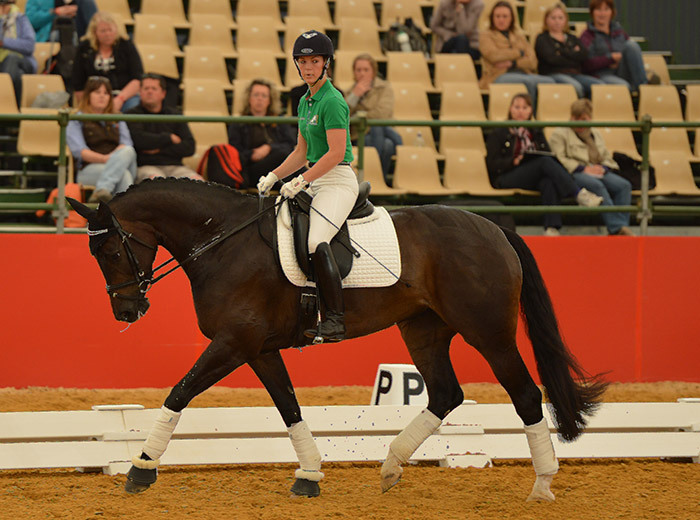
more riders follow
 Next we have Bianca Barnes and Belcam Cadel, and Robbie Soster again, this time with her Small Tour horse who is heading towards Grand Prix, the spunky chestnut, Robali Razzamatazz. During the selection class both riders piaffed and passaged with ease, but when asked about their changes looked a little pained and admitted they had problems with them. Kyra pounced on this.
Next we have Bianca Barnes and Belcam Cadel, and Robbie Soster again, this time with her Small Tour horse who is heading towards Grand Prix, the spunky chestnut, Robali Razzamatazz. During the selection class both riders piaffed and passaged with ease, but when asked about their changes looked a little pained and admitted they had problems with them. Kyra pounced on this.
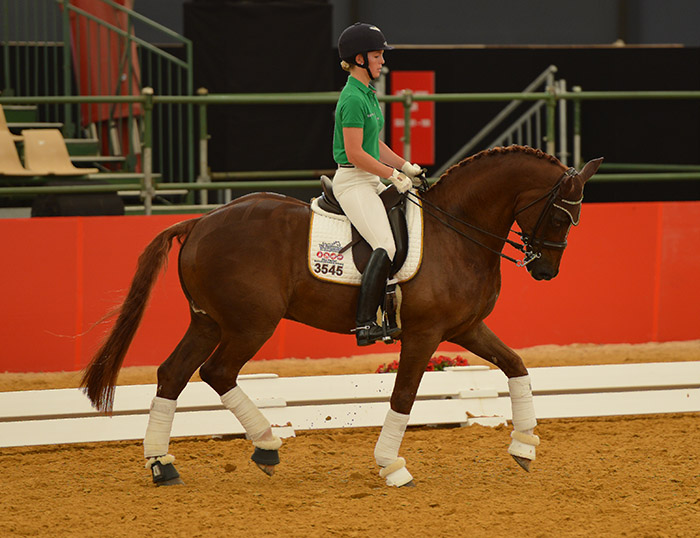
Robbie is quickly told by Kyra to bring her lower leg back underneath her and not have it so far back and to take less weight in the stirrup, “bring the toe up to yourself to allow yourself to come down into the saddle.” Razzamatazz is a very different horse to Robbie’s mare and she rides him differently too. He is a short-coupled horse with a lot of energy and tends to be a bit unsteady in the neck position.
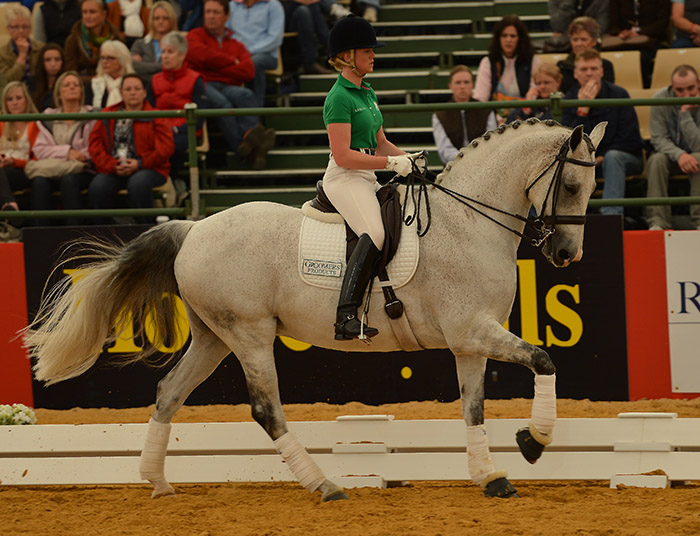
Bianca’s horse is a longer horse and is a bit high behind, he needs to be more collected. Bianca is a very neat rider, like Robbie, and has had the horse since he was 18 months old, “so all the mistakes are mine,” she joked in the selection class.
Kyra explains that the bradoon rein takes the horse up, and that the curb rein takes the horse down, noting how important it is to know which rein you’re using.
Bianca is told to feed the bradoon rein over the top of her hand and down under her thumb and to bring the curb rein under her hand so that she can clearly identify which rein she is using.
“It’s good for Bianca to ride like this because as soon as her horse goes too deep, she can use the bradoon to say, hey don’t go too deep.”
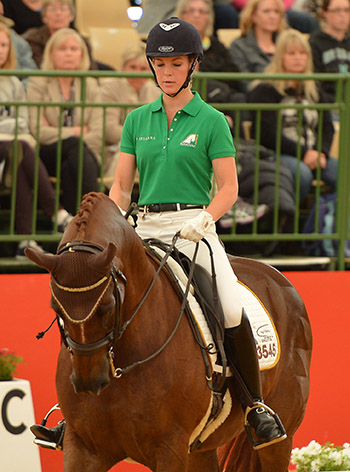
Robbie demonstrates the rein holding
Both riders are asked to shorten the trot on the circle.
Robbie’s horse is not staying straight which Kyra notices: “Imagine he is a rope dancer, if he pushes his hind legs to the right over the rope there’s no point you pushing him too far back to the left. You need him on the rope, even on the circle.”
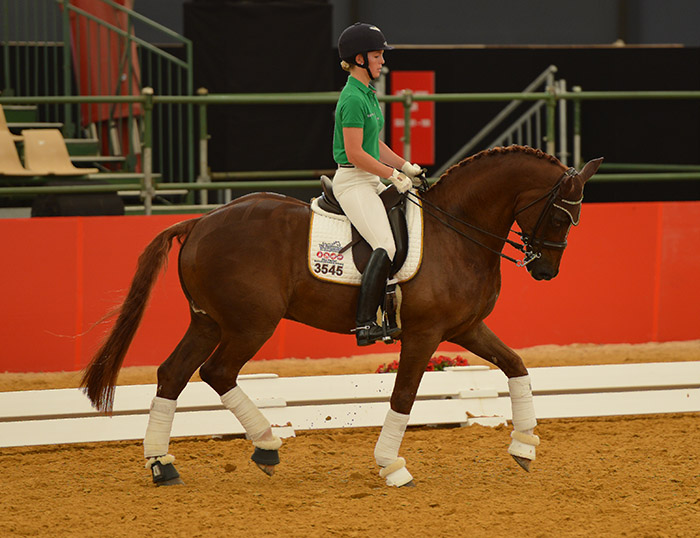
Then comes the best analogy of the day where Kyra explains the trot rhythm and power as a bouncy ball. When you start to bounce a ball on the ground you need to tap, tap, tap quickly to get that power, then, once the ball starts to get off the ground you can slow the rhythm.
“You need to notice this in passage, quicken up to get the bigger bounce.”
She extends this, saying it’s not about lifting the ball up off the ground, it’s how you send it down. And it’s the same with the horse, it’s not about the leg coming up, it’s the down step that’s important not the up step. “It’s all about how the horse lands and then pushes up.”
When Robbie tries again with the passage Kyra tells her to “think of the down step” and it really makes sense and the everyone in the audience is watching the way Razzamatazz puts his legs down.
The riders then move on to canter work and changes: Kyra’s cunning plan all along…
Bianca is up first and the changes are downhill and aren’t clean. Kyra gets her counter-cantering on the left rein, staying on the inside track so she can do a little half pass when she wants to. The horse keeps popping in un-asked-for changes. They work on straightness in the canter, activating the hind leg and not letting him change. It is much better and the horse’s bottom doesn’t come up high this time. It makes sense, if a horse is downhill it doesn’t have the power to make a good change because all its weight is on the front legs.
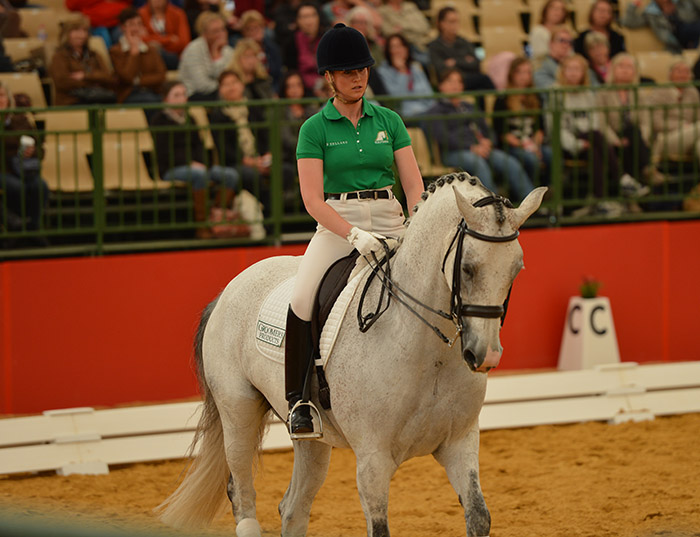
“You don’t do the next change without the canter being ready. You’re worrying about will he do the next change, not about is the canter ready.”
“Bianca you need to be more strict with yourself about when you change. The quality of your canter is defeating your changes. The weight is in his left foreleg so he can’t pick it up to change cleanly.”
Robbie had warned Kyra in the selection class that Razzamatazz had the tendency to get hot in his changes and the cute little redhead does get a bit fizzy and Robbie finds it harder to sit deep in the saddle.
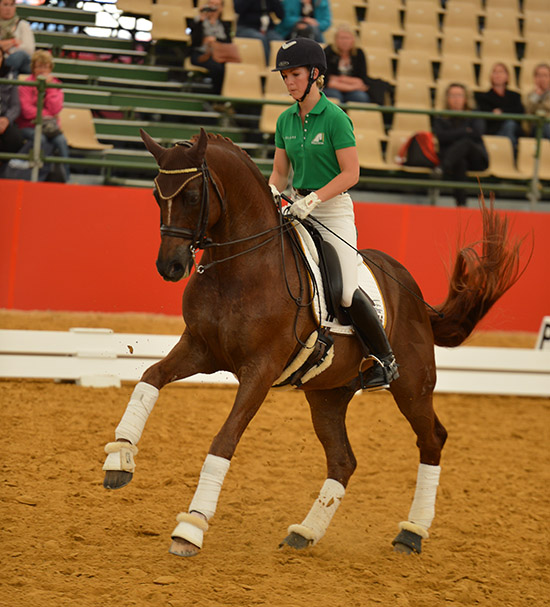
Razz gets short behind in his changes while his front legs fly out. You can see that Robbie is being pushed out of the saddle as the horse gets hollow, which makes it hard for her sit and she ends up going away from his back instead of sitting on him.
“Feel like you plonk yourself down like a jelly fish and say – hey I’m staying here you have to carry me.”
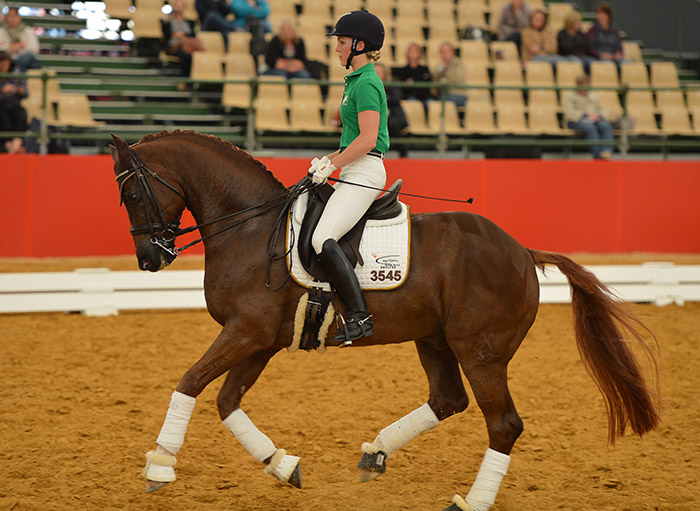
“He won’t jump more through behind until he comes off his forehand.”
Kyra physically moves Robbie around in the saddle and gets her sitting deeper, lifting her legs from the hip joint; the changes improve. But as the horse gets hotter, he gets tenser and again shorter behind.
“You don’t need to do three changes, just do one change and keep the good canter.”
“Either you take what they’ve always done or you ask them to change and allow them to be a bit confused.”
They do one excellent diagonal with clean changes, but the next is messy – “make him straight first then do the change, look where you are going to keep him straight.”
“I think there are good changes in the horse, you just need to find a way to get there without him going back or forward or sideways.”
As the riders depart Kyra thanks them for their efforts. Bianca laughs, commenting on how bad the changes were, “I know they were,” laughs Kyra, “that’s why we went there! It is such a common problem.”
Shannon McKimmie is the last guinea pig for the day and what a tall slender guinea pig combination she makes with her 18hh gelding, Ambassi (by Samba Hit), who is seven years old.
They start by throwing off effortless changes around the arena, so it’s apparent we won’t be working on that…
 As the horse is so tall Kyra discusses how important it is for him to be balanced, especially as he has a high centre of gravity. Kyra immediately notices that Shannon is sitting a bit crookedly and that the horse is strong to the left. Shannon is asked to turn her head to the right to look at his tail (on the left rein). They continue flying changes with the rider turned to the outside of the arena and the horse is much straighter.
As the horse is so tall Kyra discusses how important it is for him to be balanced, especially as he has a high centre of gravity. Kyra immediately notices that Shannon is sitting a bit crookedly and that the horse is strong to the left. Shannon is asked to turn her head to the right to look at his tail (on the left rein). They continue flying changes with the rider turned to the outside of the arena and the horse is much straighter.
“This allows her to feel what is happening with the horse,” explains Kyra, “she can feel if he is balanced.”
“The rider may look crooked to the left, but it also means her hips, knees, feet, hands and elbows are all crooked as well. I can’t change each individual part of her body by saying now move your hip, now move your knee etc, but my moving her trunk you can get the big picture change.”
And it’s true, when Shannon sits normally you notice her left hand is high and she is twisted, but as soon as she turns her trunk these problems disappear. If Kyra had simply said, keep your hand still, which other instructors have surely said already, then the same change would not have happened.
“I give you new tools to try, don’t throw away your tools, just add new tools.”
The trot work is lovely so they try for passage – Ambassi gets rather upset and runs off, backs away and rears. He looks very confused.
“That’s ok, just go forward, don’t try and stop him, we won’t punish him, trot instead of passage when he gets in trouble in passage.”
“You are teaching him passage so be thankful for each single step that is better than the last. Don’t be greedy.”
They try passage in a rising trot, which keeps the horse going forward. It looks quite strange, but since his reaction to passage was ‘I don’t want to go forward’, then this keeps him forward. The passage settles and he is balanced.
They try cantering: the horse takes off, looking for the exit, trying to piaffe.
Kyra insists the balance must be there before they ask for canter. “He is a big horse so he needs to be balanced before you ask him to do anything.”
“Carrrnter” (that’s with the Scandinavian accent), “goooood, soh, soh, soh, goood”. (Kyra also makes a delightful purring noise that she directs to the horses.)
They try passage again and he gets confused, she sends him forward and he canters. “Let him canter, say go, well done. Don’t leave him stuck in that tense moment. Ask without pressurizing.”
“You have to teach him to do it and to like it. So that it really goes into his brain, oh she wants me to do this, not canter, ah, ok.”
Shannon keeps him balanced, asks gently and the passage is there.
“You never know where you are going to go because he was anxious with the big atmosphere.”
Kyra finishes the master class by saying:
“To become a master at anything – computers, horses, anything – they say it takes 10,000 hours. So if you ride for an hour almost every day then that’s about 32 years…”
But I guess that also means everyone has to keep learning, keep trying, and that the riders that we saw today can’t expect perfection just yet…
I caught up with Robbie Soster after the master class:
How did she compare with other trainers you have worked with?
“Super, my regular trainer, Miguel Tavora thought she fitted in quite well with him. He’s very classically trained and so I am, because of that, and he’s very particular about your body influencing the collection, and that you shouldn’t have to rely on the rein for everything, and Kyra was very similar. I went and watched her ride in the warm up in the evening and just a very similar type of message I think. It was great.”
